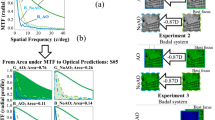Abstract
Whenever the eye views a spatially-varying gradient of luminance, the Mach bands arise, causing a subjective distribution different from the luminance distribution of the field of view. This phenomenon has been used for the determination of the contrast-transfer function of the visual system when working under normal viewing conditions, i.e., operating in a region where both luminance and detail size are well above threshold. The Mach bands have been measured by making subjective photometric comparisons and the data have been analyzed under the assumption of linearity of response to input. The hypothesis that the visual system may be treated as an approximately linear link in the imaging chain is satisfied best when the luminances are plotted logarithmically. The possibility of this type of investigation is discussed. The result found is compared with apparent subjective contrast measurements of a sine-wave spatial luminance distribution.
Similar content being viewed by others
References
Bryngdahl, O.: Eine neue Methode zur Bestimmung der Übertragungseigenschaften des Gesichtssinnes. Naturwissenschaften 51, 177 (1964).
De Mott, D.: Direct measures of the retinal image. J. opt. Soc. Amer. 49, 571 (1959).
Flamant, F.: Structure de l'image rétinienne. Rev. opt. 34, 433 (1954).
Granit, R.: Receptors and sensory perception, chaps. 1 and 8. New Haven: Yale University Press 1955.
Hartline, H. K., and F. Ratliff: Spatial summation of inhibitory influences in the eye of Limulus, and the mutual interaction of receptor units. J. gen. Physiol. 41, 1049 (1958).
Keesey, Ü. T., and L. A. Riggs: Visibility of Mach bands with imposed motions of the retinal image. J. opt. Soc. Amer. 52, 719 (1962).
Krauskopf, J.: Light distribution in human retinal images. J. opt. Soc. Amer. 52, 1046 (1962).
Lowry, E. M., and J. J. De Palma: Sine-wave response of the visual system. I. The Mach phenomenon. J. opt. Soc. Amer. 51, 740 (1961).
Marimont, R. B.: Linearity and the Mach phenomenon. J. opt. Soc. Amer. 53, 400 (1963).
Menzel, E.: Der Gesichtssinn als linearer Übertragungskanal und die Machschen Streifen. Naturwissenschaften 46, 316 (1959).
Ooue, S.: Response function of the eye. J. appl. Phys. (Japan) 28, 531 (1959).
Ratliff, F., W. H. Miller, and H. K. Hartline: Neural interaction in the eye and the integration fo receptor activity. Ann. N.Y. Acad. Sci. 74, 210 (1958).
Riggs, L. A., F. Ratliff, and Ü. T. Keesey: Appearance of Mach bands with a motionless retinal image. J. opt. Soc. Amer. 51, 702 (1961).
Schadé, O. H.: Optical and photoelectric analog of the eye. J. opt. Soc. Amer. 46, 721 (1956).
Westheimer, G., and F. W. Campbell: Light distribution in the image formed by the living human eye. J. opt. Soc. Amer. 52, 1040 (1962).
Author information
Authors and Affiliations
Rights and permissions
About this article
Cite this article
Bryngdahl, O. Visual transfer characteristics from Mach band measurements. Kybernetik 2, 71–77 (1964). https://doi.org/10.1007/BF00288560
Received:
Issue Date:
DOI: https://doi.org/10.1007/BF00288560




